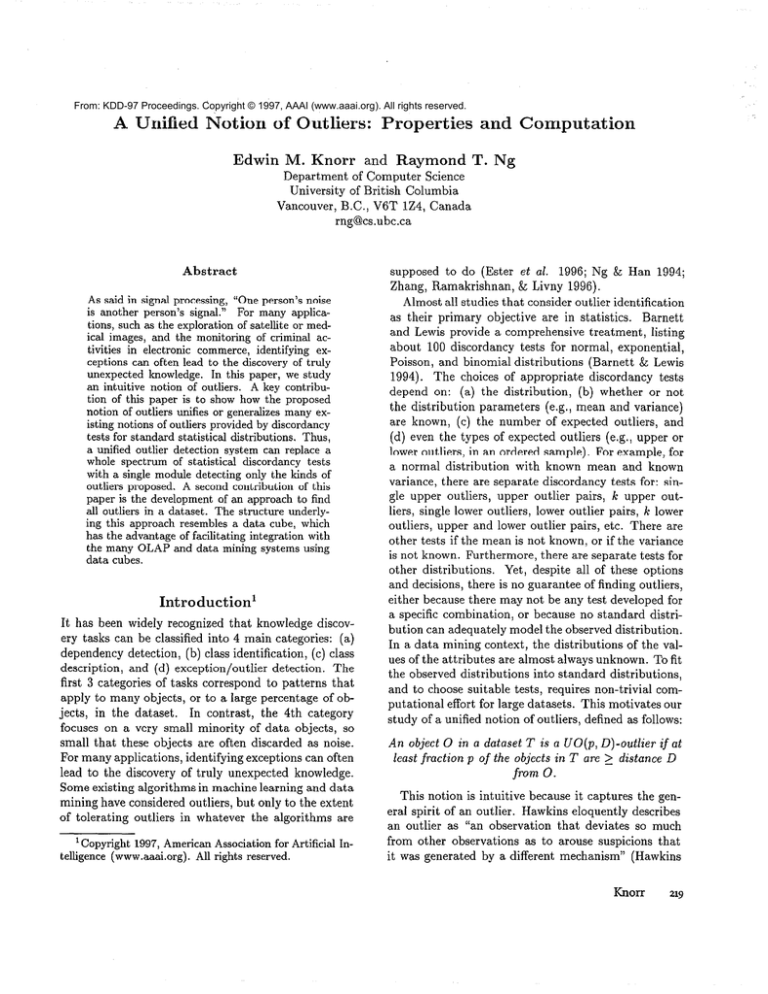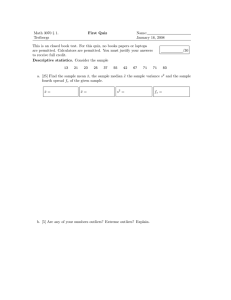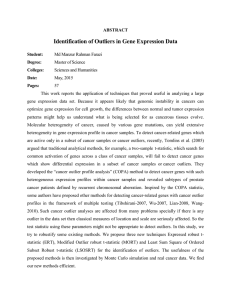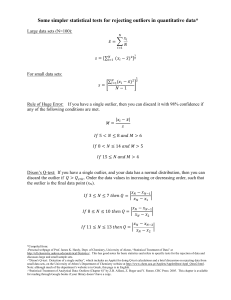
From: KDD-97 Proceedings. Copyright © 1997, AAAI (www.aaai.org). All rights reserved.
A Unified
Notion
Edwin
of Outliers:
M. Knorr
Properties
and Raymond
and
Computation
T. Ng
Department of Computer Science
University of British Columbia
Vancouver, B.C., V6T 124, Canada
mg@cs.ubc.ca
Abstract
supposed to do (Ester et ~1. 1996; Ng & Han 1994;
Zhang, Ramakrishnan, & Livny 1996).
Almost all studies that consider outlier identification
as their primary objective are in statistics. Barnett
and Lewis provide a comprehensive treatment, listing
about 100 discordancy tests for normal, exponential,
Poisson, and binomial distributions (Barnett & Lewis
1994). The choices of appropriate discordancy tests
depend on: (a) the distribution,
(b) whether or not
the distribution parameters (e.g., mean and variance)
As said in signal processing, “One person’s noise
is another person’s signal.” For many applications, such as the exploration of satellite or medical images, and the monitoring of criminal activities in electronic commerce, identifying
exceptions can often lead to the discovery of truly
unexpected knowledge. In this paper, we study
an intuitive notion of outliers. A key contribution of this paper is to show how the proposed
notion of outliers unifies or generalizes many ex:d:m, II”l,I”IID
,,,c:,,, “I
,c “UbUT;ID
,..A,:,,, IJ’
,.-,.,:,4,.-l
A:,.,,...,-l,..“..
Kl”Ul~
“Y’U~U I..,
uy uKL”LuarlLy
tests for standard statistical distributions.
Thus,
a unified outlier detection system can replace a
whole spectrum of statistical discordancy tests
with a single module detecting only the kinds of
outliers proposed. A second contribution of this
paper is the development of an approach to find
all outliers in a dataset. The structure underlying this approach resembles a data cube, which
has the advantage of facilitating integration with
the many OLAP and data mining systems using
data cubes.
are known. , Ic\
number -_ of extxctd
\., the
.-_- ---__--r -----.
Introduction’
It has been widely recognized that knowledge discov^I_. C--l.^^- I.^
-l---:cc^~ lllb”
:-I.- ‘AI Illall,
--:- cabegurlea;
-..A--.^.L--. \a,
I-\
cry
w.LJKScam
“t: claYs,,lal
dependency detection, (b) class identification, (c) class
description, and (d) exception/outlier
detection.
The
first 3 categories of tasks correspond to patterns that
apply to many objects, or to a Iarge percentage of objects, in the dataset. In contrast, the 4th category
focuses on a very small minority of data objects, so
small that these objects are often discarded as noise.
l7nr
A “I nl2n7,2nnl;r5lt;nn~
“‘CVA’J wyy~‘~‘cu”‘“L’u,
;rl,mt;hrina
nvmnt;nnc
IU,,““A’J “16 bArryuL”lr”
olltlierq
- -1____L, and
____
(d) even the types of expected outliers (e.g., upper or
lower outliers, in an ordered sample). For example, for
a normal distribution with known mean and known
variance, there are separate discordancy tests for: single upper outliers, upper outlier pairs, k upper outhers, single lower outliers, lower outlier pairs, k lower
outliers, upper and lower outlier pairs, etc. There are
other tests if the mean is not known, or if the variance
is not known. Furthermore, there are separate tests for
other distributions.
Yet, despite all of these options
and decisions, there is no guarantee of finding outliers,
either because there may not be any test developed for
a specific combination, or because no standard distribution can adequately model the observed distribution.
In a data mining context, the distributions of the values of the attributes are almost always unknown. To fit
the observed distributions into standard distributions,
and to choose suitable tests, requires non-trivial computational effort for large datasets. This motivates our
study of a unified notion of outliers, defined as follows:
,-sn “IUblI
r-,ft,m
bWII
lead to the discovery of truly unexpected knowledge.
Some existing algorithms in machine learning and data
mining have considered outliers, but only to the extent
of tolerating outliers in whatever the algorithms are
‘Copyright 1997, American Association for Artificial
telligence (www.aaai.org).
All rights reserved.
In-
This notion is intuitive because it captures the general spirit of an outlier. Hawkins eloquently describes
an outlier as “an observation that deviates so much
from other observations as to arouse suspicions that
it was generated by a different mechanism” (Hawkins
Knorr
219
1980). As such, this notion is a natural candidate
for situations where the observed distribution does not
fit any standard distribution, or where no discordancy
test has been developed. In this paper, we show that
for many discordancy tests, if an object 0 is an outlier
according to a specific discordancy test, then 0 is also
a UO(p, D)-outlier for some suitably defined p and D.
Data mining, by definition, implies large quantities
of data; therefore, efficiency or scalability is an important goal. A key contribution of this paper is the
development of a partitioning-based
approach for detecting UO(p, D)-outliers.
Its efficiency, particularly
for datasets with low dimensionality, will be demonstrated by the performance results presented at the
end of this paper. Another advantage of our approach
is that its underlying data structure resembles a data
cube (Gray et al. 1995). This makes our method easily integratable with the many OLAP systems and data
mining systems using data cubes.
Properties
Relationships
of UO(p, II)-Outliers:
with Existing
Notions
Proof Outline:
We use probabilities to reflect the
number of points lying in a D-neighbourhood.
Specifically, the probability is 1 -p that the distance between
2 randomly selected points, 0 and Q; is less than or
equal to D. Let TI and TZ be random variables that are
normally distributed with parameters p and g2 i.e.,
and 22 = yi
Tl , T2 - N(p, c2)). Define 21 = v
as standard normal variables (i.e., Zl,&
- N(0, 1)).
Using a table that lists areas for ranges --oo < .Zi 5 z
under the standard normal curve to 4 decimal places,
and given po = 0.9988 and DO = O.l3a, we get:
Pr(ITl
- Tzl > 0.134
> 0.9988
u
PT(JTI - Tz1 5 0.13~)
5 0.0012
u
PT(TI - 0.13r < Tz < TI + 0.13~)
5 0.0012
u
Pr(Z1 - 0.13 5 22 5 21 + 0.13)
5 0.0012
U
21 5 -3.0000
u
Tl<p-3g
or
or
21 2 3.0000
Tl>p++u
0
Let N be the number of objects in the input dataset
T. Each object is identified with the same k attributes.
k is called the dimensionality of the dataset. Suppose
there is an underlying distance metric function F that
gives the distance between any pair of objects in T.
For an object 0, the D-neighbourhood of 0 contains
the set of objects Q E T that are within distance D
from 0, i.e., {Q E T 1 F(O,Q) 5 D}. The fraction p
is the minimum fraction of objects in T that must be
outside the D-neighbourhood of an outlier.
Note that if the value 3a in DefNornzal is changed
to some other value, such as 40-, the above proof procedure can easily be modified with the corresponding
po and Do to show that UO(p, D) still unifies the new
definition of DefNormal.
Barnett and Lewis give many specialized tests for
identifying outliers in normal distributions with known
or unknown means and/or standard deviations.
Instead of using the standard normal curve, some of those
tests use a t-distribution
curve, which has a fatter tail
than the normal curve. Nevertheless, the same proof
procedure shown above still works with appropriate
modifications.
As a concrete example, Barnett and
Lewis give DefN6 for testing for an upper and lower
outlier pair in a normal distribution
with unknown
mean and variance. In a more detailed report (Knorr
& Ng 1997), we give a proof showing that UO(p, D)
unifies DefN6 with po = 0.999 and DO = 0.2. Due to
very limited space, we omit those details. Details and
proofs are also available for the following lemmas.
Outliers
Outliers
In this section, we show how our notion of UO(p, D)outliers relates to existing notions of outliers, most of
which turn out to be specific instances of ours.
Definition
1 We say that UO(p, D) unifies or generalizes another definition Def for outliers, if there exist
specific values PO,DO such that object 0 is an outlier
0
according to Def iff 0 is a UO(po, Do)-outlier.
in Normal
Distributions
For a normal distribution, outliers can be considered to
be points that lie 3 or more standard deviations (i.e.,
2 3~) from the mean p (Freedman, Pisani, & Purves
1978).
Definition
2 Let T be a set of values that is truly
normally distributed with mean p and standard deviation 6. Define DefNormal as follows: t E T is an outlier
cl
iff % 2 3 or y
5 -3.
Lemma 1 UO(p, D) unifies DefNorntal with po =
0.9988, DO = O.l3a, i.e., t is an outlier according to
DefNornaal iff t is a UO(O.9988,0.13a)-outlier.
220
KDD-97
in Other
Distributions
Consider the following test for finding a single upper
outlier in an exponential sample with unknown parameter (Barnett & Lewis 1994). Let the sampled values
be ordered as z(l), . . . , ~(~1, and let the test statistic Tl
be defined as (&ci,)
* Let T be the observed value
for TI , and SP(T) be the significance probability that
TI takes values more discordant than r.
Barnett and Lewis provide an example using 131 excess cycle times in steel manufacture, whose distribution reasonably approximates an exponential distribution with parameter 0.14. Let us consider this example.
Definition
3 Define DefEcp as follows. Observation
t is an outlier (according to test statistic Tl defined
above) iff SP(r) < 0.01. For example, for the 131
excess cycle times, ~(131) = 92 is an outlier because
0
SP(T) 5 0.00017.
Lemma 2 For an exponential
rameter 0.14, UO(p, D) unifies
and D 0 = 0.0001.
distribution
&?fEzpwith
with papo = 0.999
0
For a binomial distribution, t can be defined as an
outlier iff r is greater than or equal to a specific critical value (listed in tables of such values (Barnett &
Lewis 1994)). Again, a proof is available showing that
UO(p, D) unifies this definition of outliers in a binomial distribution.
The following test can be used to find outliers in a
Poisson distribution with parameter p = 3.0.
Definition
4 Define DefpoiSSon.as follows: t is an out0
lier iff t > 8.
Lemma 3 UO(p,D)
0.9962 and Do = 1.
Comparison
and
___--
unifies
with
with-__- T’
Ista
-__J-_
Defpoissors with
Sequential
Clnsterincr
__-L1-__-_a
that DBSCAN, as a clustering algorithm, aims to produce maximal-size clusters and is reluctant to label objects as outliers. Neither DBSCAN nor CLARANS nor
BIRCH is designed to unify the kinds of distributiondependent discordancy tests described earlier.
po =
II
Exceptions
Alpnrithms
---o---‘
-----’
All of the outlier identification studies that we have
come across are in statistics expect for the “sequential exceptions” approach (Arning, Agrawal, & Raghavan 1996), whereby a dataset is searched for implicit
redundancies. Specifically, data items called sequenGnI
O’
PPDmt;nl7E
nvtT.nrtnrl
“I 1,1..,11mc,.Am;n~
IlIwAxlllllu~ tha
“11b I.OIL.
OYUU
bL.rb~‘
Y”‘UGlVCl
CUICb‘
%“IU~“xAL,wh;rh
duction in Kolmogorov complexity. Unlike UO(p, D)outlier detection (and all statistical discordancy tests,
and most distance-based data mining works), the approach of Arning, et al. does not require a metric distance function.
Thus, because of model differences,
their approach and ours will not necessarily identify
the same outliers, even for a dataset that is applicable
to both approaches.
Data clustering algorithms assign similar objects
in a dataset to the same classes; however, they
provide little support for identifying outliers (Kaufman & Rousseeuw 1990; Fisher 1987). CLARANS,
BIRCH, and DBSCAN are clustering algorithms designed specifically for data mining applications.
In
CLARANS (Ng & Han 1994), an object is (removed
as) “noise” if its removal raises the silhouette coefficient of the clusters. In BIRCH (Zhang, Ramakrishnan, & Livny 1996), an object is (removed as) noise if
it is “too far from its closest seed,” where a seed is some
representative object such as the centroid of a cluster.
DBSCAN classifies objects as core, border, or outlying,
based on the reachability and connectivity of the object being clustered (Ester et al. 1996). A key here is
An
Although
Approach
for Finding
UO(p, D)-Outliers
All
limited space does not permit the inclusion
ant-l
rnmnlc4t.v
-..--A.AI.-‘.‘vJ
analv& --- of
nlmrit.hm
“* ~I,P
--_ I-‘
o -__-..___ fQr fi.n&ng
.“..--J
all UO(p, D)-outliers, we present the underlying properties and the general approach for computing those
outliers, followed by preliminary experimental results.
Underlying
Cell
Structure
and
Properties
A naive algorithm for detecting all IrO(p, D)-outlier~
for given values of p and D would be to count, for
each object Q, the number of objects in the Dneighbourhood of Q. A more optimized algorithm is
to build and search a spatial indexing structure, such
as a k-d tree (Bentley 1975). Instead, our approach for
finding all UO(p, D)- ou tl iers relies on an underlying
cell structure. As will become obvious later, the idea
is to reduce object-by-object processing to cell-by-cell
processing, thereby gaining efficiency. For ease of presentation, we show the cell structure and its properties
for the 2-dimensional case, i.e., k = 2. Later, we describe what changes are required to generalize to higher
dimensions.
The 2-dimensional space spanned by the data objects is partitioned into cells or squares of length I =
6.
Let CX,y denote the cell that is at the intersection
of row z and column y. The Layer-l (Li) neighbours
of cz,, are all the immediate neighbouring cells of C,,,
as defined in the usual sense, i.e.,
~l(G,,)
=
In the 2-dimensional case, a typical cell (except for cells
that are on the boundary of the cell structure) has 8
Li neighbours.
Property
1 Any pair of objects within the same cell
q
is at most distance 4 apart.
Property
2 If C,,, is a L1 neighbour of Csc,Y, then
any object P E Cub, and any object Q E CzVY are at
cl
most distance D apart.
Property 1 is valid because the length of a diagonal of
a cell is &
= Jzs n = f. Similarly, Property 2 is
true because the distance between any pair of objects
in the two cells cannot exceed twice the length of a
diagonal of a cell. As will become obvious later, these
Knorr
221
two properties
zn nnt.liw
_.,
.,-”
are useful in ruling out many objects
rnnrlidat.w
..-*
”
.“A.-.UW
-““.
The
--.”
T.IIVP~-3 11;,‘1 neicrhhmlm
y-JwA
I
\-“,
----
o--“v---
nf
--
C,,, are all the cells within 3 cells of C3c,y, i.e.,
While Layer 1 is 1 cell thick, Layer 2 is 2 cells thick.
This is significant because of the following property.
Property
3 if C,,, + Cz,Y is neither an il nor an i2
neighbour of Cx,y, then any object P E C,,, and any
object Q E Cz,y must be at least distance D apart. 0
Because the combined thickness of L1 plus La is 3 cells,
the distance between P and Q must exceed 31 = s
>
D. In the 2-dimensional case! a typical cell> except for
boundary cells, has 72 - 3’ = 40 L:! cells.
The key idea of our approach is summarized in the
following property. For convenience, let M denote the
maximum number of objects that can be inside the Dneighbourhood of an outlier, i.e., M = N(1 - p), and
let m be the total number of cells.
Property
mr,mn
,‘“r‘G
,f
“I
4 (a) If there are > M objects in Cx,y,
tLn
,h:,,+ctJ11c “UJGLIJ”
;,
/-’
111 vl,y
:, _n
1u au
,,,cl;o,
“U~II~;I.
/lx1
\u,
Tf
II
th,nno
“IIGIG
are > M objects in Cz,yUL1 (Cz,y), none of the objects
in Cr,y is an outlier. (c) If there are < A4 objects in
Cz,y U L1(C,,,) U Lz(C~,~), every object in C,,, is an
cl
outlier.
Properties 4(a) and 4(b) are direct consequences of
Properties i and 2, and 4jcj is due to Property 3.
Note that these properties help to identify outliers or
non-outliers in a cell-by-cell manner, rather than on an
object-by-object basis. This kind of “bulk processing”
reduces execution time significantly.
Generalization
to Higher
Dimensions
To generalize from the 2-dimensional case to k > 2, we
use the same algorithm; however, to maintain Properties 1-4, (i) the length of a cell changes from I = 3
to 1 = &,
and (ii) Layer 2 is no longer 2 cells thick,
125, search times ranged from 0.11 to 0.17 secondsnnnrovima.teIv
-=r--~ -.-^- -LeJ
s@J
of k-d
t;rpe sear&
t,imes.
Wh-en
we ran our algorithm against much larger, synthetic
datasets, we obtained results even more dramatic. For
100000 tuples and 0.99 5 p 2 0.99999 (approximately), our algorithm yielded search times ranging
from 0.52 to 95.09 seconds. In comparison, a somewhat optimized brute force approach required 4.54 to
447.68 seconds. Searches using various kinds of k-d
trees exceeded the CPU timer limit of 2147 seconds.
Acknowledgments
This research has been partially sponsored by NSERC
Grant OGP0138055 and IRIS-2 Grants HMI-5 & IC-5.
References
Arning, A.; Agrawal, R.; and Raghavan, P. 1996.
A linear method for deviation detection in large
databases. In Proc. KDD, 164-169.
Barnett, V., and Lewis, T. 1994. Outliers in Statistical Data. John Wiley & Sons.
Bentley, J. L.
1975.
Multidimensional
search trees used for associative searching.
_^,^ \ _^^ ---
binary
CACM
lt((Yj:5UY-517.
Ester, M.; Kriegel, H.-P.; Sander, J.; and Xu, X. 1996.
A density-based algorithm for discovering clusters in
large spatial databases with noise. In Proc. KDD,
226-231.
Fisher, D. 1987. Knowledge acquisition via incremental conceptual clustering. Machine Learning2(2):139172.
Freedman, D.; Pisani, R.; and Purves, R. 1978. Statistics. New York: W.W. Norton.
Gray, J.; Bosworth, A.; Layman, A.; and Pirahesh, H.
1995. Data cube: A relational aggregation operator
generalizing group-by, cross-tab and sub-totals. Technical Report MSR-TR-95-22, Microsoft Research.
Hawkins, D. 1980. Identification
Chapman and Hall.
of O&hers. London:
but rather [2&l cells thick. We defer proofs and complexity analysis to a more detailed report (Knorr & Ng
1997). In ongoing work, we are studying how to optimize UO(p, D)-outlier detection for high dimensional
cases, e.g., k > 10.
Kaufman, L., and Rousseeuw, P. 1990. Finding
Groups in Data. John Wiley & Sons.
TI..
_--, D.
l-3 Xd
--I!-..
-I
llnorl’
IVI., --=
dllU 1vg,
hT- nn. T. 1997. AA ..-:fz->
u11111eu
IlUblOIl 01
Preliminary
Ng, R., and Han, J. 1994. Efficient and effective
clustering methods for spatial data mining. In Proc.
20th VLDB, 144-155.
Experimental
Results
We ran our algorithm on a 16-attribute, 856-record
dataset consisting of 1995-96 performance statistics
for players in the National Hockey League. For a 3dimensional cell structure containing 1000 cells, and
using parameters 0.99 5 p < 0.979 and 70 _< D 5
222
KDD-97
outliers. Unpublished Manuscript, Dept. of Computer
Science, University of British Columbia.
Zhang, T.; Ramakrishnan, R.; and Livny, M. 1996.
Birch: An efficient data clustering method for very
large databases. In Proc. ACM SIGMOD, 103-114.

![[#GEOD-114] Triaxus univariate spatial outlier detection](http://s3.studylib.net/store/data/007657280_2-99dcc0097f6cacf303cbcdee7f6efdd2-300x300.png)




